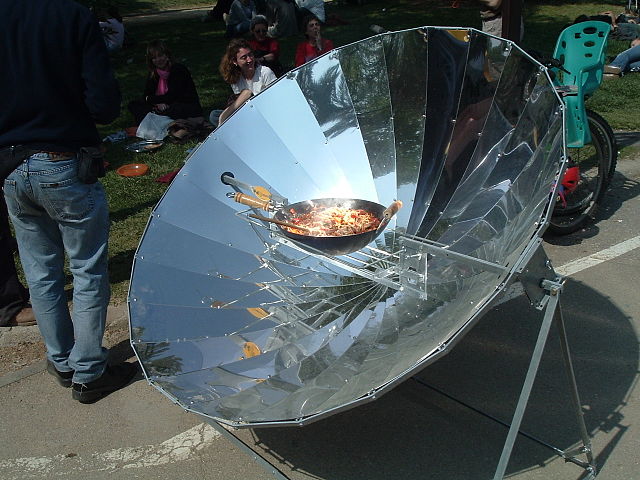Top Qs
Timeline
Chat
Perspective
Solar furnace
Focal point for concentrated sunlight; contains working fluid to be heated From Wikipedia, the free encyclopedia
Remove ads
A solar furnace is a structure that uses concentrated solar power to produce high temperatures, usually for industry. Parabolic mirrors or heliostats concentrate light (Insolation) onto a focal point. The temperature at the focal point may reach 3,500 °C (6,330 °F), and this heat can be used to generate electricity, melt steel, make hydrogen fuel or nanomaterials.

The largest solar furnace is at Odeillo in the Pyrénées-Orientales in France, opened in 1970. It employs an array of plane mirrors to gather sunlight, reflecting it onto a larger curved mirror.
Remove ads
History
Summarize
Perspective
The ancient Greek / Latin term heliocaminus means "solar furnace" and refers to a glass-enclosed sunroom intentionally designed to become hotter than the outside air temperature.[1]
Legendary accounts of the Siege of Syracuse (213–212 BC) tell of Archimedes' heat ray, a set of burnished brass mirrors or burning glasses supposedly used to ignite attacking ships, though modern historians doubt its veracity.
On 24 September 1901, Knut C. Wideen was granted a patent for a "System for collecting and utilizing solar heat", which included a solar furnace.[2]
The first modern solar furnace is believed to have been built in France in 1949 by Professor Félix Trombe. The device, the Mont-Louis Solar Furnace is still in place at Mont-Louis. The Pyrenees were chosen as the site because the area experiences clear skies up to 300 days a year.[3]
The Odeillo Solar Furnace is a larger and more powerful solar furnace. It was built between 1962 and 1968, and started operating in 1969. It's currently the most powerful, based on an achievable temperature of 3500 °C.
The Solar Furnace of Uzbekistan was built in Uzbekistan and opened in 1981 as a part of a Soviet Union "Sun" Complex Research Facility, being the world largest concentrator.[4]
Remove ads
Uses
The rays are focused onto an area the size of a cooking pot and can reach 4,000 °C (7,230 °F), depending on the process installed; for example:
- about 1,000 °C (1,830 °F) for metallic receivers producing hot air for the next-generation solar towers as it will be tested at the Themis plant with the Pegase project[5]
- about 1,400 °C (2,550 °F) to produce hydrogen by cracking methane molecules[6]
- up to 2,500 °C (4,530 °F) to test materials for extreme environment such as nuclear reactors or space vehicle atmospheric reentry
- up to 3,500 °C (6,330 °F) to produce nanomaterials by solar induced sublimation and controlled cooling, such as carbon nanotubes[7] or zinc nanoparticles[8]
It has been suggested that solar furnaces could be used in space to provide energy for manufacturing purposes.
Their reliance on sunny weather is a limiting factor as a source of renewable energy on Earth but could be tied to thermal energy storage systems for energy production through these periods and into the night.
Remove ads
Smaller-scale devices

The solar furnace principle is being used to make inexpensive solar cookers and solar-powered barbecues, and for solar water pasteurization.[9][10] A prototype Scheffler reflector is being constructed in India for use in a solar crematorium. This 50 m2 reflector will generate temperatures of 700 °C (1,292 °F) and save 200–300 kg of firewood used per cremation.[11]
See also
References
External links
Wikiwand - on
Seamless Wikipedia browsing. On steroids.
Remove ads
